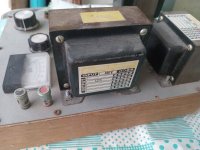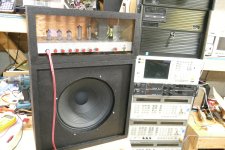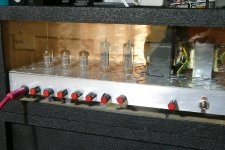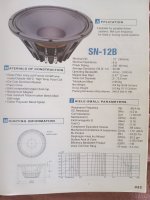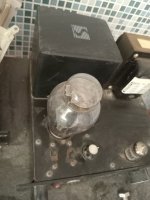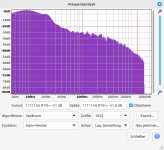These are the fundamental harmonics.
These are the fundamentals. Not harmonics.
Not the way I play it. I want response down to 80 Hz, or 40 Hz for bass. Engineers don’t get to make musical decisions.Do not mistake these with the harmonics that are pre-dominant, specially at the low notes. It turns out that for the electric guitar anything below 150~200Hz is irrelevant to perceived sound, but eats unnecessary power from the amp.
Your 50 watt transformer barely has enough inductance to avoid saturation with 220 volts RMS (620 V Peak to Peak) applied to the primary. In my experiments you will lose a lot of that inductance when you restack the core to create a gap. Power (mains) transformers rarely work well for SE use. A universal (2 X 120 volt) power transformer can be used as an OPT in some push pull applications WITH some derating that will vary from transformer to transformer, so It needs to be tested.For 80 to 5khz, why 220v50hz 50W transformer can't be used for single ended 6L6 ? The irons need to be rearranged to make an airgap. 220/10v can work as 4k/8 ohm.
I built this guitar amp as my "lets see what I can make for $99.99" in the Hundred Buck Amp Challenge. In order to squeeze in at just under $100 I used an Antek AN-0509 50 VA 2 X 115 (230 VCT) to 2 X 9V (wired in parallel) to make a 2600 ohm to 4 ohm OPT. The amp worked and made about 17 watts running a pair of UL84's on 335 volts. The UL84 is a 45 volt 100 mA heater variant of the 6CW5.
Now that the HBAC is just a memory and a long forum thread, I ripped the power toroid out of the amp and installed a real "80 VA 6600 to 0-4-8-16 ohm" OPT used as a 3300 ohm to 0-2-4-8 ohm OPT in its place. The OPT is the larger of the two transformers seen in the amp. Power output went up to 22 watts and the sound quality improved greatly, especially in that irrelevant first octave. The low E string sounds crystal clear with for real bass to it You can play full six note chords at a rather loud volume level without IMD........until you roll into the volume knobs.
Attachments
A 50hz designed transformer can double its power at 100hz. If DC is applied, it will decrease the inductance but still sufficient for 80hz. Only 6w 80 Hz is needed from a 50w 50hz.
The gm of pentode increases by anode current. If the inductor decreases it, it can linearize it.
The gm of pentode increases by anode current. If the inductor decreases it, it can linearize it.
I looked for local speaker manufacturers, I found only one model intended for guitar sold for $18. This brand sells the diaphragms as replacement part that might interest to those like @JMFahey manufacturer their own speakers.

I have 9 PAudio SN12B in array that I might try one. It is intended to be used in large outdoor PA systems in multiple for 80-800 hz. If I drive in current mode, the impedance at 5khz is 3x that of 200 hz giving 10db extra level but it is not expressive above 500hz. Not good for guitar unless I add a reflecting parabola. I bought 12 years ago for $80 a piece. It is used in occidental world in pairs with front horn loaded for very high efficiency woofer.
I have 9 PAudio SN12B in array that I might try one. It is intended to be used in large outdoor PA systems in multiple for 80-800 hz. If I drive in current mode, the impedance at 5khz is 3x that of 200 hz giving 10db extra level but it is not expressive above 500hz. Not good for guitar unless I add a reflecting parabola. I bought 12 years ago for $80 a piece. It is used in occidental world in pairs with front horn loaded for very high efficiency woofer.
Attachments
The fundamental is the first harmonic H1These are the fundamentals. Not harmonics.
Not the way I play it. I want response down to 80 Hz, or 40 Hz for bass. Engineers don’t get to make musical decisions.
@tubelab, I had inverse adventure with power supply transformer.
While conceiving my 300B/2A3C SET, to determine the correct load, I ordered beforehand from a local power supply transformer winder a 48VA 270v/ several outputs. I chose the right ratio and ordered an expensive 5hz to 100khz 20W single ended OPT.
Of course the bass and high frequencies got improved but the voice range lost most of its presence.
While conceiving my 300B/2A3C SET, to determine the correct load, I ordered beforehand from a local power supply transformer winder a 48VA 270v/ several outputs. I chose the right ratio and ordered an expensive 5hz to 100khz 20W single ended OPT.
Of course the bass and high frequencies got improved but the voice range lost most of its presence.
Attachments
I analyzed the spectrum of the sound sample. It shows indeed a max around 100Hz.These are the fundamentals. Not harmonics.
Not the way I play it. I want response down to 80 Hz, or 40 Hz for bass. Engineers don’t get to make musical decisions.
Keep in mind the record includes the bass drum as well.
Anyway for that style of guitar playing 80Hz cutoff maybe feasable
Attachments
Here's an anecdote that ties in with distortion perception:
A couple of years ago a made a set of 4 active filters with the whole "KISS" lore, etc. Instead of the standard NE5532 op-amps, I used discrete buffers (because you don't really need op-amps if it's unity gain Sallen-Key filters) made with resistor-loaded BC850 NPNs. From memory, the simulated distortion was in the order of 0.1% THD @ at some moderate 100-200mV line level. ("It'll be fine!...")
At first, everything was great. The improvement from 2-channel passive to 4-channel active was fairly substantial.
It seemed like actual months had passed, when I began to notice a persistent grainy distortion, almost like loose wires (which was a serious possibility, given the impeccable quality of my prototypes but everything was firmly soldered). Once my attention was focused on it, the level at which I could hear it kept going down.
but everything was firmly soldered). Once my attention was focused on it, the level at which I could hear it kept going down.
I was quite disappointed with myself and learnt a few things, but looking back it seems consistent with that weird habit where people audition new equipment for outrageously extended periods. Not to mention, phenomenon where factory workers take time to "learn" to hear their coworkers over the drone of heavy machinery.
BTW, things that don't sound great — or are 'fatiguing' or whatever — fall into disuse. It's just a fact. Like an old hi-fi that only ever gets used for HT but the CD collection never gets played. So you have to look at what people do with their equipment and watch what their daily driver is, and just nod politely when they say something.
~~
So, back-to-back 2 second clips can only say so much. Never mind the microphone and the rest of the signal chain for the video, but it seems like the whole focus was on getting a "pretty similar" first impression. One box goes "braaang" and the other box also goes "braaang"? Check!
Obviously there's no way I could hear any difference between some of the clips, but it seems like the maker of the video may have been a bit dismissive of 'subtle' differences. Obviously, solid state amplification was "good enough" for the tackle box.
Lastly, he seemed to get lots of praise from PHDs in the comments for the methodology, but there was no 'integration', no checking back to see if the design choices had something to do with the different speaker drivers, which he'd gotten rid of earlier. (No long-term studies; just typical...) Maybe variable 'A' (like the tone pots) of amp 1 were specially chosen because of driver A from the same amp, but if you swap in driver D from one of the other amps, sure, you may discover that power tubes X and Y sound identical, but you end up missing the artistic "wow" of tone pots A + driver A altogether.
A couple of years ago a made a set of 4 active filters with the whole "KISS" lore, etc. Instead of the standard NE5532 op-amps, I used discrete buffers (because you don't really need op-amps if it's unity gain Sallen-Key filters) made with resistor-loaded BC850 NPNs. From memory, the simulated distortion was in the order of 0.1% THD @ at some moderate 100-200mV line level. ("It'll be fine!...")
At first, everything was great. The improvement from 2-channel passive to 4-channel active was fairly substantial.
It seemed like actual months had passed, when I began to notice a persistent grainy distortion, almost like loose wires (which was a serious possibility, given the impeccable quality of my prototypes
I was quite disappointed with myself and learnt a few things, but looking back it seems consistent with that weird habit where people audition new equipment for outrageously extended periods. Not to mention, phenomenon where factory workers take time to "learn" to hear their coworkers over the drone of heavy machinery.
BTW, things that don't sound great — or are 'fatiguing' or whatever — fall into disuse. It's just a fact. Like an old hi-fi that only ever gets used for HT but the CD collection never gets played. So you have to look at what people do with their equipment and watch what their daily driver is, and just nod politely when they say something.
~~
So, back-to-back 2 second clips can only say so much. Never mind the microphone and the rest of the signal chain for the video, but it seems like the whole focus was on getting a "pretty similar" first impression. One box goes "braaang" and the other box also goes "braaang"? Check!
Obviously there's no way I could hear any difference between some of the clips, but it seems like the maker of the video may have been a bit dismissive of 'subtle' differences. Obviously, solid state amplification was "good enough" for the tackle box.
Lastly, he seemed to get lots of praise from PHDs in the comments for the methodology, but there was no 'integration', no checking back to see if the design choices had something to do with the different speaker drivers, which he'd gotten rid of earlier. (No long-term studies; just typical...) Maybe variable 'A' (like the tone pots) of amp 1 were specially chosen because of driver A from the same amp, but if you swap in driver D from one of the other amps, sure, you may discover that power tubes X and Y sound identical, but you end up missing the artistic "wow" of tone pots A + driver A altogether.
The low-frequency components are in the initial transient of the string being picked. They are part of the sound of a real instrument.These are the fundamental harmonics. Do not mistake these with the harmonics that are pre-dominant, specially at the low notes. It turns out that for the electric guitar anything below 150~200Hz is irrelevant to perceived sound, but eats unnecessary power from the amp.
Ed
Obviously, you're not a guitar player ;-)These are the fundamental harmonics. Do not mistake these with the harmonics that are pre-dominant, specially at the low notes. It turns out that for the electric guitar anything below 150~200Hz is irrelevant to perceived sound, but eats unnecessary power from the amp.
As mentioned, the attack transient may well go lower, but more importantly IMD products from overdrive/distortion can go much lower and often are the 'meat' in the tone when you play chords.
Interesting, a YT video enlightened me that - for guitar - they now have actual products called a "flat-response powered speaker". These devices are intended to be used with a modeling stomp box and therefore are engineered to be "transparent" to the sound of the incoming signal.
Well, there's lots of flat response powered speakers around - non powered ones too. Sounds like something has come full circle to me.
In another thread, Mr Cocobar asked what type of speaker can I use with my mixer / flamma / voice / guitar / bass setup. More answers and opinions than Duncan has Donuts. Seems to be a thing - now, these days - that a guitar player could show up with a brand new "flat-response powered speaker" intended for guitar amplification, his modeling stomp box and guitar - and that would be as legitimate as any other contrivance.
"flat-response powered speaker". I just cant get over it - so I'll get over it. What'll they think of next? My Behringer Ultracoustic - an amplifier intended for voice and acoustic guitar I suppose could sit behind some modeling stomp does everything box just as well as some new hunk of physical material someone wants to sell me. "flat-response powered speaker" cant wait for the first thread "How do I make a flat-response powered speaker?"
Well, there's lots of flat response powered speakers around - non powered ones too. Sounds like something has come full circle to me.
In another thread, Mr Cocobar asked what type of speaker can I use with my mixer / flamma / voice / guitar / bass setup. More answers and opinions than Duncan has Donuts. Seems to be a thing - now, these days - that a guitar player could show up with a brand new "flat-response powered speaker" intended for guitar amplification, his modeling stomp box and guitar - and that would be as legitimate as any other contrivance.
"flat-response powered speaker". I just cant get over it - so I'll get over it. What'll they think of next? My Behringer Ultracoustic - an amplifier intended for voice and acoustic guitar I suppose could sit behind some modeling stomp does everything box just as well as some new hunk of physical material someone wants to sell me. "flat-response powered speaker" cant wait for the first thread "How do I make a flat-response powered speaker?"
Obviously you are not the one to judge other people.Obviously, you're not a guitar player ;-)
But we are heading of topic. Me helping again🫢
Who can post frequency response of known midd size guitar amps so we get that out of the way? I imagine they drop a lot under 100 hz and bass knob ads more buttom when needed 4 full stacks in a row would give more, but they are miked anyways. Anyways Guitar amps use middrange speaker drivers. -Not woofers, so that could give us a clue.
Cheers!
Who can post frequency response of known midd size guitar amps so we get that out of the way? I imagine they drop a lot under 100 hz and bass knob ads more buttom when needed 4 full stacks in a row would give more, but they are miked anyways. Anyways Guitar amps use middrange speaker drivers. -Not woofers, so that could give us a clue.
Cheers!
Not so far. There's an amplified speaker combo, meant for guitar, current selling product, that - guaranteed - sounds different than other guitar amplifiers. Because all it does is amplify without adding any character of its own - if that's even possible. All the tone being generated in the accompanying studio-pedal.But we are heading of topic.
I suppose it could be argued that only in the case of the two taken together...would be a valid comparison.
- Home
- Live Sound
- Instruments and Amps
- Do really guitar amps sound different?
